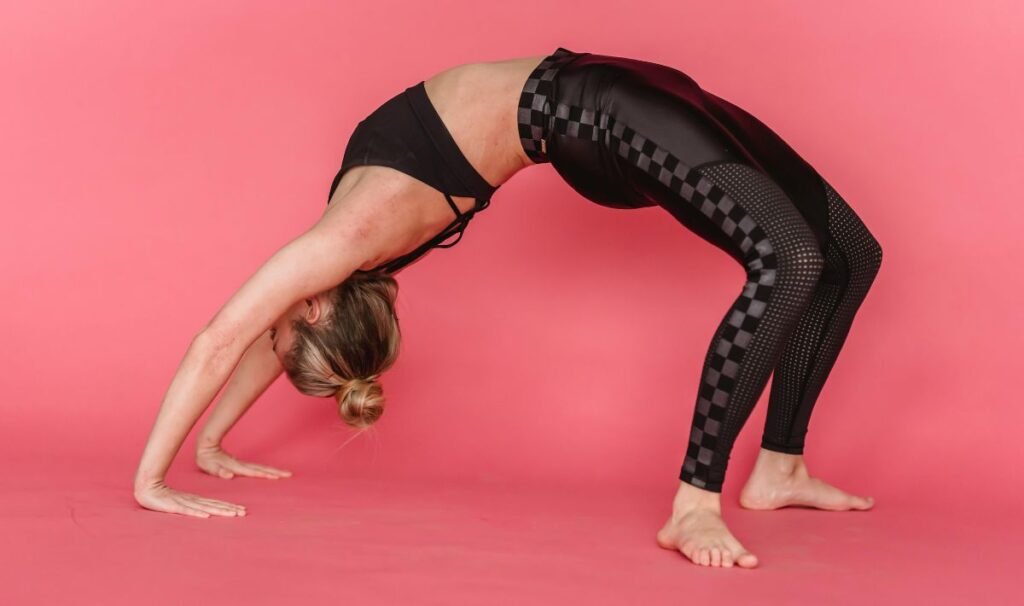Yoga has a way of making us feel grounded, strong, and balanced—all while helping us stretch and tone. Among the many yoga poses that offer these benefits, the Crescent Lunge Pose (also known as High Lunge Pose or Crescent Lunges) stands out. It’s a beginner-friendly pose that strengthens the legs, stretches the hips, and opens the chest, making it a favorite among yogis of all levels.
In this guide, we’ll break down everything you need to know about the Crescent Lunge Pose, including step-by-step instructions, its benefits, and variations to suit your practice. Whether you’re a seasoned practitioner or new to yoga, this pose has something valuable for everyone.
What Is Crescent Lunge Pose?
The Crescent Lunge Pose, or High Lunge, is a standing pose that focuses on balance, strength, and flexibility. It’s named for the crescent-like curve of the body when the arms are raised overhead. This pose is commonly used in vinyasa flows, sun salutations, and as a preparation for deeper backbends and balancing poses.
How to Perform
Let’s dive into the steps to practice Crescent Lunge Pose safely and effectively.
Step-by-Step Guide to Crescent Lunge Pose
- Start in Downward-Facing Dog
- Begin on your hands and knees, then lift your hips toward the ceiling to form an inverted “V” shape.
- Make sure your hands are shoulder-width apart and your feet are hip-width apart.
- Step One Foot Forward
- Step your right foot forward between your hands.
- Align your knee over your ankle to protect your joints and ensure stability.
- Lift Your Back Heel
- Rise onto the ball of your left foot, keeping your heel lifted and your leg extended straight back.
- Press firmly through your back toes to engage your leg muscles.
- Engage Your Core and Lift Your Torso
- Use your abdominal strength to lift your torso upright.
- Stack your shoulders directly over your hips.
- Raise Your Arms Overhead
- Stretch your arms toward the ceiling, palms facing each other.
- Keep your shoulders relaxed and away from your ears.
- Adjust Your Alignment
- Square your hips toward the front of your mat.
- Tuck your tailbone slightly to avoid overarching your lower back.
- Hold and Breathe
- Stay in the pose for 3–5 breaths, deepening your stretch with each inhale and grounding through your legs with each exhale.
- Release the Pose
- To exit, lower your arms, place your hands on the mat, and step back to Downward-Facing Dog.
- Repeat on the other side.
Readmore: How Yoga Can Help Improve Your Posture
Readmore: The Benefits of Practicing Yoga Outdoors
Benefits
The Crescent Lunge Pose offers a wealth of physical and mental benefits. Here’s why you should incorporate it into your yoga practice:
1 . Strengthens the Lower Body
- Engages your quadriceps, hamstrings, glutes, and calves, building strength and endurance in your legs.
2. Stretches the Hip Flexors
- Opens tight hip flexors, which are often contracted from long periods of sitting.
3. Improves Balance and Stability
- Challenges your balance and helps you develop better coordination.
4. Enhances Flexibility
- Promotes greater flexibility in the hips, spine, and shoulders.
5. Builds Core Strength
- Activates your abdominal muscles to support the alignment of your spine.
6. Boosts Energy Levels
- The pose opens the chest and increases lung capacity, promoting better oxygen flow and boosting energy.
7. Prepares for Advanced Poses
- Serves as a foundational pose for advanced backbends, standing balances, and even inversions.
Common Mistakes
While Crescent Lunge Pose is beginner-friendly, it’s easy to make a few mistakes. Here are some tips to keep your practice safe and effective:
- Knee Beyond Ankle
- Ensure your front knee stays stacked directly over your ankle to avoid strain.
- Overarching the Lower Back
- Keep your core engaged and tailbone slightly tucked to maintain a neutral spine.
- Hunched Shoulders
- Relax your shoulders away from your ears when lifting your arms.
- Unstable Back Leg
- Keep your back leg strong and engaged for better balance.
Variations
To make the pose more accessible or challenging, you can try these variations:
1 . Crescent Lunge with Hands-on Hips
- If balancing with arms overhead feels too intense, place your hands on your hips for extra stability.
2. Low Lunge (Anjaneyasana)
- Lower your back knee to the ground for a more gentle stretch.
3. Crescent Lunge Twist
- Bring your hands into a prayer position at your chest and twist toward your front leg, hooking your elbow outside your knee.
4. Side Stretch Variation
- Lean your torso slightly to the side, stretching through the obliques.
5. Crescent Lunge with Backbend
- Arch your back gently and look upward, deepening the chest opening.
Tips for Practicing
- Warm Up First
- Prepare your body with poses like Cat-Cow, Low Lunge, and Warrior I.
- Use Props
- Place yoga blocks under your hands for added support if needed.
- Focus on Breath
- Keep your breathing steady to maintain balance and stay relaxed.
- Take It Slow
- Build strength and flexibility gradually, especially if you’re new to yoga.
Incorporating into Your Practice
Crescent Lunge Pose can be included in various sequences:
- Sun Salutations: Flow from Downward Dog to Crescent Lunge to build heat.
- Strength Training: Use it in combination with Warrior poses to strengthen your legs.
- Cooling Down: Transition into Low Lunge or Child’s Pose for a restorative finish.
Final Thoughts
The Crescent Lunge Pose is a versatile and empowering addition to any yoga practice. Its ability to build strength, improve balance, and open up the body makes it a must-try for yogis at all levels. By following the steps, exploring variations, and avoiding common mistakes, you can enjoy its full range of benefits.
So roll out your mat, step into your lunge, and let this pose elevate your yoga journey. Crescent Lunges are not just a pose—they’re a pathway to strength, flexibility, and mindfulness.
Happy practicing!
FAQs
Is Crescent Lunge Pose suitable for beginners?
Yes, Crescent Lunge Pose is beginner-friendly and can be modified to suit your flexibility and strength level. For example, beginners can lower the back knee to the ground (Low Lunge) for added support. Using props like yoga blocks for balance can also make the pose more accessible.
What muscles does Crescent Lunge Pose target?
Crescent Lunge Pose primarily targets the quadriceps, hamstrings, glutes, and calves in the lower body. It also stretches the hip flexors, engages the core, and strengthens the back and shoulders as you lift your arms overhead.
How long should I hold Crescent Lunge Pose?
Holding Crescent Lunge Pose for 3–5 deep breaths on each side is a good starting point. As you become more comfortable, you can extend the duration to build endurance and deepen the stretch. Always listen to your body and avoid overstraining.

Sonu is a passionate yoga teacher with over 6+ years of experience helping individuals find balance, strength, and inner peace through the transformative power of yoga. As the creator of Pure Yoga Vibes, Sonu shares expert insights, inspiring practices, and a wealth of knowledge to support your wellness journey. Dedicated to creating a space for growth and mindfulness, Sonu’s mission is to make yoga accessible and enjoyable for everyone. For inquiries or collaborations, feel free to reach out at contact@pureyogavibes.com.



